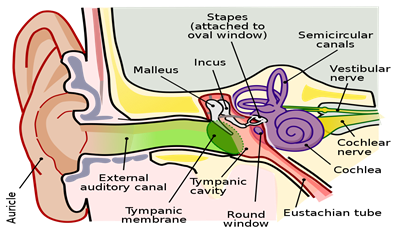Explain the structure of middle and internal ear with the help of diagram.

• Middle ear –
a. It contains three ossicles called malleus (hammer), incus (anvil) and stapes (stirrup) which are attached to one another in a chain-like fashion.
b. The malleus is attached to the tympanic membrane and the stapes is attached to the oval window of the cochlea.
c. A Eustachian tube connects the middle ear cavity with the pharynx and helps in equalising the pressures on either sides of the ear drum.
• Inner Ear –
a. It is also called Labyrinth.
b. It is fluid-filled.
c. It has two parts – the bony and the membranous labyrinth.
d. The bony labyrinth is a series of channels.
e. Inside these channels lies the membranous labyrinth. It is surrounded by a fluid called perilymph.
f. The membranous labyrinth is filled with a fluid called endolymph.
g. The coiled portion of the labyrinth is called cochlea.
h. The space within cochlea called scala media is filled with endolymph.
i. At the base of the cochlea, the scala vestibuli ends at the oval window, while the scala tympani terminate at the round window which opens to the middle ear.
j. The inner ear also contains a complex system called vestibular apparatus composed of three semi-circular canals and the otolith and is located above the cochlea.
k. Each semi-circular canal lies in a different plane at right angles to each other. The base of canals is swollen and is called ampulla
l. Ampulla contains a projecting ridge called crista ampullaris which has hair cells. The saccule and utricle contain a projecting ridge called macula.